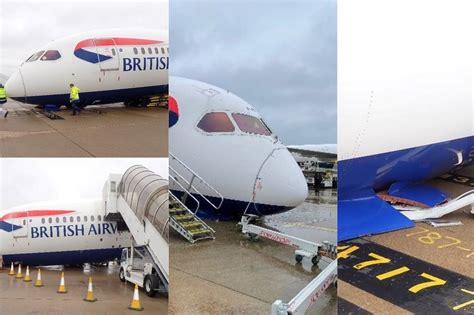
A Boeing 787 Dreamliner, the same model as a LATAM Airlines jet that experienced a sudden mid-air plunge earlier this month, has been involved in four emergency landings in the past month, raising concerns about potential safety issues and prompting scrutiny of Boeing’s manufacturing and maintenance practices.
Boeing 787 Dreamliner Faces Scrutiny After Emergency Landings and Whistleblower Allegations
A Boeing 787 Dreamliner, the same model as the LATAM Airlines plane that experienced a significant mid-air incident, has been involved in four emergency landings within a single month, fueling concerns about the aircraft’s safety and Boeing’s quality control measures. The incidents coincide with renewed attention to whistleblower allegations regarding compromised safety standards at Boeing, creating a challenging environment for the aerospace giant.
The recent emergency landings have involved various airlines and routes, adding to the growing apprehension surrounding the 787 Dreamliner. While details of each incident vary, the frequency with which these events have occurred has prompted investigations by aviation authorities and internal reviews by the affected airlines. According to the Yahoo News report, these incidents come on the heels of concerns raised by a whistleblower regarding Boeing’s safety culture.
The mid-air incident involving the LATAM Airlines 787 Dreamliner flight from Sydney to Auckland, which resulted in injuries to passengers and crew, has amplified these concerns. Although the cause of the LATAM incident is still under investigation, it involved a sudden and unexpected drop, leading to speculation about potential mechanical or electrical malfunctions.
The FAA and other regulatory bodies are now facing increased pressure to thoroughly investigate the recent incidents and the whistleblower’s claims to determine if systemic issues exist within Boeing’s manufacturing or maintenance processes. The investigations will likely involve detailed inspections of the aircraft involved, reviews of maintenance records, and assessments of Boeing’s quality control procedures.
Whistleblower’s Concerns
The recent safety concerns are further compounded by allegations from a whistleblower, as reported by Yahoo News, who raised concerns over compromised safety standards within Boeing. While the specific details of the whistleblower’s claims remain confidential to protect their identity, the allegations reportedly involve potential lapses in quality control, inadequate training, and pressure on employees to overlook potential safety issues in order to meet production deadlines.
These allegations, if substantiated, could have significant implications for Boeing, potentially leading to regulatory sanctions, reputational damage, and increased scrutiny of its manufacturing practices. It could also impact passenger confidence in Boeing aircraft and potentially affect future orders.
Details of the Emergency Landings
While specific details on all four emergency landings are still emerging, publicly available information provides some insight into the nature of these incidents:
-
Incident 1: Details regarding the first emergency landing are limited, but it reportedly involved a mechanical issue that required the aircraft to divert to the nearest suitable airport. The airline involved has not been publicly identified.
-
Incident 2: The second incident reportedly involved a potential electrical fault detected during flight. The pilots followed standard procedures and made a precautionary landing at an alternative airport.
-
Incident 3: Details on the third incident are also scarce, but it is believed to have involved a potential hydraulic system issue. The pilots declared an emergency and safely landed the aircraft.
-
Incident 4: Specific details about the fourth emergency landing are still being gathered. What is known so far is that the flight was diverted due to some technical issue.
It’s crucial to note that an emergency landing does not necessarily indicate a major safety defect. These are often precautionary measures taken by pilots to ensure passenger safety in the event of a potential malfunction. However, the frequency of these incidents involving the same aircraft model raises legitimate concerns.
FAA Investigation and Regulatory Oversight
The Federal Aviation Administration (FAA) has a critical role in ensuring the safety of air travel. Following the recent incidents and whistleblower allegations, the FAA is expected to conduct thorough investigations into the matter. These investigations will likely involve:
-
Reviewing Boeing’s manufacturing processes: The FAA will examine Boeing’s quality control procedures, training programs, and oversight mechanisms to identify any potential weaknesses.
-
Inspecting affected aircraft: The FAA may conduct detailed inspections of the Boeing 787 Dreamliner aircraft involved in the emergency landings to identify any commonalities or potential defects.
-
Interviewing Boeing employees: The FAA may interview Boeing employees, including those who have raised concerns about safety standards, to gather information about potential lapses in quality control.
-
Analyzing flight data: The FAA will analyze flight data from the affected aircraft to identify any patterns or anomalies that may have contributed to the incidents.
Based on the findings of its investigations, the FAA may take corrective actions, such as requiring Boeing to implement design changes, improve manufacturing processes, or enhance training programs. The FAA could also impose fines or other penalties on Boeing if it is found to have violated safety regulations.
Boeing’s Response
Boeing has stated that it is cooperating fully with the FAA and other regulatory authorities in their investigations. The company has also said that it is committed to ensuring the safety of its aircraft and that it takes all safety concerns seriously.
In a statement released following the emergency landing incidents, Boeing said: “Safety is our top priority, and we are working closely with our customers and regulators to address any concerns. We are committed to ensuring that our aircraft are safe and reliable.”
Boeing is likely to face intense scrutiny from regulators, airlines, and the public in the coming months. The company will need to demonstrate that it is taking all necessary steps to address the safety concerns and restore confidence in its aircraft.
Impact on Airlines and Passengers
The recent safety concerns surrounding the Boeing 787 Dreamliner could have a significant impact on airlines and passengers. Airlines that operate the 787 Dreamliner may face increased maintenance costs and potential disruptions to their flight schedules if the FAA orders inspections or grounding of the aircraft.
Passengers may also be affected by the safety concerns. Some passengers may be hesitant to fly on the 787 Dreamliner, while others may experience delays or cancellations if airlines reduce their use of the aircraft.
The overall impact on airlines and passengers will depend on the outcome of the FAA’s investigations and the corrective actions that Boeing takes.
Expert Opinions
Aviation experts have weighed in on the situation, emphasizing the importance of a thorough investigation to determine the root cause of the incidents.
“It’s crucial to understand what’s causing these emergency landings,” said John Nance, an aviation safety consultant. “Are they isolated incidents, or do they indicate a systemic problem with the aircraft?”
Other experts have highlighted the importance of addressing the whistleblower’s allegations.
“If there are indeed lapses in quality control at Boeing, that needs to be addressed immediately,” said Dr. Hassan Shahidi, an aviation safety expert. “The safety of passengers and crew depends on it.”
Historical Context
Boeing has faced scrutiny in the past over safety concerns. The 737 MAX crashes in 2018 and 2019, which killed 346 people, led to a worldwide grounding of the aircraft and a series of investigations that revealed flaws in the aircraft’s design and certification process.
The 737 MAX crisis damaged Boeing’s reputation and led to significant financial losses. The company has since taken steps to improve its safety culture and manufacturing processes, but the recent incidents involving the 787 Dreamliner suggest that challenges remain.
The Future of the 787 Dreamliner
The future of the Boeing 787 Dreamliner will depend on the outcome of the ongoing investigations and the actions that Boeing takes to address the safety concerns. If Boeing can demonstrate that it is committed to safety and that it has taken steps to prevent future incidents, the 787 Dreamliner is likely to remain a popular aircraft with airlines and passengers.
However, if the investigations reveal systemic problems with the aircraft or Boeing’s manufacturing processes, the 787 Dreamliner could face a more uncertain future. The aircraft’s reputation could be damaged, and airlines may be hesitant to order new 787 Dreamliners.
The current situation underscores the importance of rigorous safety oversight and a strong safety culture within the aviation industry. It also highlights the crucial role that whistleblowers play in identifying potential safety hazards.
Impact on Boeing’s Stock and Financials
The ongoing safety concerns and investigations surrounding the Boeing 787 Dreamliner are likely to have a negative impact on Boeing’s stock price and financial performance. Investors may become concerned about the potential for increased costs, delays in aircraft deliveries, and damage to Boeing’s reputation.
Airlines may also demand compensation from Boeing for any losses they incur as a result of the safety concerns. The overall financial impact on Boeing will depend on the severity of the problems and the corrective actions that the company takes.
Broader Implications for the Aviation Industry
The recent events involving the Boeing 787 Dreamliner have broader implications for the aviation industry as a whole. They highlight the importance of maintaining high safety standards and the need for continuous improvement in manufacturing processes and quality control.
The aviation industry is highly regulated, and airlines and manufacturers are subject to strict safety standards. However, the recent incidents suggest that there is always room for improvement.
The industry must learn from these events and take steps to prevent similar incidents from happening in the future. This includes investing in new technologies, improving training programs, and fostering a strong safety culture.
Conclusion
The series of emergency landings involving the Boeing 787 Dreamliner, coupled with whistleblower allegations regarding safety standards, presents a serious challenge for Boeing and the aviation industry. The ongoing investigations by regulatory authorities and Boeing’s internal reviews will be critical in determining the root cause of these incidents and implementing corrective actions. The outcome will not only impact the future of the 787 Dreamliner but also shape public confidence in air travel and the overall safety culture within the aviation sector. The situation warrants close monitoring as investigations unfold and Boeing takes measures to address the concerns raised. Maintaining transparency and prioritizing safety are paramount to restoring confidence and ensuring the continued safety of air travel.
FAQ: Boeing 787 Dreamliner Safety Concerns
-
What is the main concern regarding the Boeing 787 Dreamliner?
The main concern is the occurrence of four emergency landings of the same model in a single month, coupled with a recent mid-air incident involving a LATAM Airlines 787 Dreamliner. These events, along with whistleblower allegations about compromised safety standards at Boeing, have raised questions about the aircraft’s safety and Boeing’s quality control.
-
What happened on the LATAM Airlines flight involving the 787 Dreamliner?
The LATAM Airlines 787 Dreamliner flight from Sydney to Auckland experienced a sudden and unexpected drop mid-air, resulting in injuries to passengers and crew. The cause of the incident is still under investigation, but it has heightened concerns about potential mechanical or electrical malfunctions.
-
What are the whistleblower allegations against Boeing?
The whistleblower allegations, as reported by Yahoo News, involve potential lapses in quality control, inadequate training, and pressure on employees to overlook potential safety issues to meet production deadlines. The specific details remain confidential to protect the whistleblower’s identity.
-
What is the FAA doing to address the safety concerns?
The FAA is expected to conduct thorough investigations into the matter, which may include reviewing Boeing’s manufacturing processes, inspecting affected aircraft, interviewing Boeing employees, and analyzing flight data. Based on its findings, the FAA may take corrective actions, such as requiring Boeing to implement design changes, improve manufacturing processes, or enhance training programs.
-
How might these safety concerns affect airlines and passengers?
Airlines that operate the 787 Dreamliner may face increased maintenance costs and potential disruptions to their flight schedules if the FAA orders inspections or grounding of the aircraft. Passengers may experience delays or cancellations if airlines reduce their use of the aircraft, and some passengers may be hesitant to fly on the 787 Dreamliner.
Extended Analysis and Contextual Information
To provide a more comprehensive understanding, it’s essential to delve deeper into various aspects of the situation, including the specifics of emergency landings, historical safety issues with Boeing, the role of regulatory bodies, and the potential long-term consequences for the aviation industry.
Detailed Examination of Emergency Landings:
While the initial news reports outline the occurrence of four emergency landings within a month involving Boeing 787 Dreamliners, understanding the nuances of each incident is crucial. Emergency landings are not always indicative of a catastrophic failure; often, they are precautionary measures taken by pilots when a potential problem is detected. These landings can be triggered by various factors, ranging from minor mechanical issues to more significant system malfunctions. A detailed breakdown of the possible causes and the procedures involved in emergency landings sheds light on the complexity of these events.
-
Possible Causes: Emergency landings can stem from various factors, including engine failures, hydraulic system malfunctions, electrical faults, sensor errors, cabin pressurization problems, or even medical emergencies involving passengers or crew. Understanding the root cause in each of the four incidents is paramount to assessing the severity and potential systemic issues.
-
Standard Procedures: When an emergency situation arises, pilots follow strict procedures outlined in their training and the aircraft’s operating manual. These procedures involve assessing the situation, communicating with air traffic control, declaring an emergency, and selecting the nearest suitable airport for landing. The safety of passengers and crew is the top priority, and pilots are trained to make decisions that minimize risk.
-
Maintenance and Inspections: After an emergency landing, the aircraft undergoes thorough inspections and maintenance to identify and rectify the problem. The findings from these inspections are reported to regulatory authorities, which may conduct their own investigations to determine if there are any systemic issues that need to be addressed.
Historical Safety Issues with Boeing:
Boeing, as one of the world’s leading aircraft manufacturers, has a long and storied history. However, it has also faced its share of safety challenges. The most prominent recent example is the 737 MAX crisis, which resulted in the grounding of the aircraft worldwide and significant reputational damage to Boeing. Understanding the historical context of safety issues within Boeing is crucial to assessing the current situation.
-
737 MAX Crisis: The 737 MAX crisis was triggered by two fatal crashes in 2018 and 2019, which claimed the lives of 346 people. Investigations revealed that a faulty sensor and a poorly designed flight control system, known as MCAS (Maneuvering Characteristics Augmentation System), contributed to the crashes. The crisis exposed flaws in Boeing’s design and certification processes, as well as its relationship with regulatory authorities.
-
Past Safety Concerns: Beyond the 737 MAX crisis, Boeing has faced other safety concerns throughout its history. These concerns have ranged from design flaws to manufacturing defects to maintenance issues. Each incident has prompted investigations and corrective actions, shaping the company’s approach to safety.
-
Lessons Learned: The historical safety issues at Boeing have underscored the importance of rigorous safety oversight, a strong safety culture, and effective communication between manufacturers, regulators, and airlines. The lessons learned from past incidents should inform the company’s response to the current concerns surrounding the 787 Dreamliner.
Role of Regulatory Bodies:
Regulatory bodies like the FAA play a crucial role in ensuring the safety of air travel. These agencies are responsible for setting safety standards, certifying aircraft, and overseeing airlines and manufacturers. Understanding the role of regulatory bodies and their interactions with Boeing is essential to assessing the credibility and effectiveness of safety oversight.
-
FAA Oversight: The FAA has broad authority to oversee all aspects of aviation safety in the United States. This includes conducting inspections, issuing regulations, and enforcing compliance with safety standards. The FAA also works closely with international regulatory bodies to harmonize safety standards and share information about potential risks.
-
Certification Process: The process of certifying a new aircraft is rigorous and involves extensive testing and analysis. The FAA reviews the aircraft’s design, manufacturing processes, and operating procedures to ensure that it meets all safety standards. The certification process also involves ongoing monitoring and surveillance to identify any potential issues that may arise after the aircraft enters service.
-
Enforcement Actions: The FAA has the power to take enforcement actions against airlines and manufacturers that violate safety regulations. These actions can range from fines and warnings to grounding aircraft and revoking certifications. The FAA’s enforcement actions serve as a deterrent and help to ensure compliance with safety standards.
Potential Long-Term Consequences:
The ongoing safety concerns surrounding the Boeing 787 Dreamliner could have significant long-term consequences for Boeing, the aviation industry, and the traveling public. These consequences could include financial losses, reputational damage, changes in regulatory oversight, and shifts in passenger confidence.
-
Financial Impact: The safety concerns could lead to increased costs for Boeing, including expenses related to investigations, inspections, repairs, and compensation to airlines. The company’s stock price could also be negatively affected, and it may face challenges in securing new orders for the 787 Dreamliner.
-
Reputational Damage: The safety concerns could damage Boeing’s reputation as a leading aircraft manufacturer. Airlines and passengers may lose confidence in the company’s products, leading to a decline in sales and market share.
-
Regulatory Changes: The safety concerns could prompt regulatory bodies to implement stricter oversight of Boeing and the aviation industry. This could include increased inspections, more rigorous certification processes, and tougher enforcement actions.
-
Passenger Confidence: The safety concerns could erode passenger confidence in air travel. Some passengers may be hesitant to fly on the 787 Dreamliner, while others may avoid flying altogether. This could have a negative impact on the demand for air travel and the profitability of airlines.
Whistleblower Protection and Encouragement
The role of whistleblowers in identifying safety concerns cannot be overstated. Protecting and encouraging individuals to come forward with information about potential risks is crucial to maintaining a safe aviation system.
-
Legal Protections: Whistleblowers are often protected by laws that prevent retaliation from their employers. These laws also provide incentives for whistleblowers to report wrongdoing, such as financial rewards for providing information that leads to successful enforcement actions.
-
Confidentiality: It is essential to protect the confidentiality of whistleblowers to prevent them from being identified and subjected to retaliation. Regulatory bodies and law enforcement agencies must take steps to ensure that whistleblowers can report concerns without fear of reprisal.
-
Ethical Considerations: Companies should foster a culture that encourages employees to speak up about safety concerns without fear of retribution. This includes providing clear channels for reporting concerns, investigating allegations promptly and thoroughly, and taking appropriate corrective actions.
Transparency and Communication
Transparency and open communication are essential for building trust and restoring confidence in the aviation industry. Boeing and regulatory bodies should be transparent about the ongoing investigations and the corrective actions that are being taken.
-
Public Updates: Boeing should provide regular updates to the public about the progress of the investigations and the steps it is taking to address the safety concerns. These updates should be clear, concise, and informative, avoiding technical jargon and providing context for the information being presented.
-
Collaboration with Stakeholders: Boeing should collaborate with airlines, regulatory bodies, and other stakeholders to ensure that all concerns are addressed and that the necessary corrective actions are taken. This collaboration should be based on trust, respect, and a shared commitment to safety.
-
Accountability: Boeing should hold itself accountable for any failures that contributed to the safety concerns. This includes taking responsibility for design flaws, manufacturing defects, or inadequate oversight. Accountability is essential for restoring trust and preventing future incidents.
Conclusion
The situation surrounding the Boeing 787 Dreamliner is complex and multifaceted. The recent emergency landings, coupled with whistleblower allegations, have raised serious concerns about the aircraft’s safety and Boeing’s quality control. The ongoing investigations by regulatory authorities and Boeing’s internal reviews will be critical in determining the root cause of these incidents and implementing corrective actions. The outcome will not only impact the future of the 787 Dreamliner but also shape public confidence in air travel and the overall safety culture within the aviation sector. Maintaining transparency, prioritizing safety, and fostering a culture of accountability are paramount to restoring confidence and ensuring the continued safety of air travel. The situation requires careful monitoring and a commitment to continuous improvement to prevent future incidents and maintain the highest standards of safety in the aviation industry.









